The Russell Shale Brick Company

This plaque commemorating the Russell Shale Brick Company was added to the Historical Plaque Program in 2021, in partnership with the Russell and District Historical Society. This plaque is located 300 metres east of Eadie Road along the Recreational Trail.
Early Brick-Making
Russell was a flourishing brick making centre from as early as 1864. The earliest brick makers were Solomon Pillar, William Fetterly and John Helmer.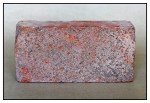
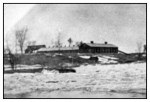
By 1884, the directories listed three brick factories operated by Horatio Loucks, Hamilton Rombough and James Turnbull. These small operations produced moulded brick using the local clay from which some of the oldest buildings in Russell were constructed. The Henry Tweed House was built in 1860, the John Hall House was built in 1875, and the County Registry Office in 1874.
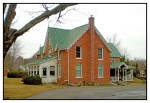
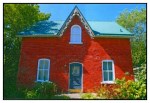
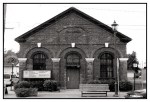
Other prominent buildings, in the village, constructed with clay brick included: the Anglican church in 1886 and the United church in 1887.
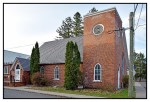
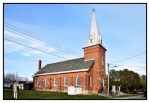
In 1907, Louck’s brick factory was purchased by Dr. Dugald S. MacDougall and Robert Fraser and they named it the Russell Brick and Tile Company Ltd. They raised the required capital funds by selling shares.

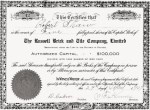
They hired James Ball, a British brick making expert, as manager. On his arrival, he determined that the local clay was too soft to make good quality bricks. James Ball found a good workable clay shale on George Hays farm (Lot 18, Concession 3) in North Russell about 4 km north of the brickyard and an open pit quarry was started. This red shale is part of the Queenston formation that is the youngest of all the bedrock formations in the area. It is composed of red clay particles with little cementation that makes it easy to break down when exposed to weathering. The underlying red shale bedrock is the origin of the distinctive red soil in the fields of North Russell.
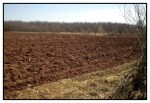
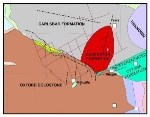 In 1907, the North Russell quarry was opened, mining was a seasonal operation. The quarry was pumped dry, late in the spring, and the rock was blasted, and a steam shovel was used to load quarry cars on a narrow-gauge railway. By mid-summer, there was enough shale delivered to the brick works obtained for the next year of brick making.
In 1907, the North Russell quarry was opened, mining was a seasonal operation. The quarry was pumped dry, late in the spring, and the rock was blasted, and a steam shovel was used to load quarry cars on a narrow-gauge railway. By mid-summer, there was enough shale delivered to the brick works obtained for the next year of brick making.

Initially, the quarry cars were wooden-sided and were pulled up out of the quarry by teams of horses. The cars would then roll down the hill on their own to the brick plant. In 1911, the Russell Brick and Tile Co. was sold, and the new Russell Shale and Brick Ltd, under G.F. Hodgins, and in 1912 they built a new plant, adjacent to the New York Central railway line.
The narrow-gauge railway came down Eadie Road and looped through the brick works.
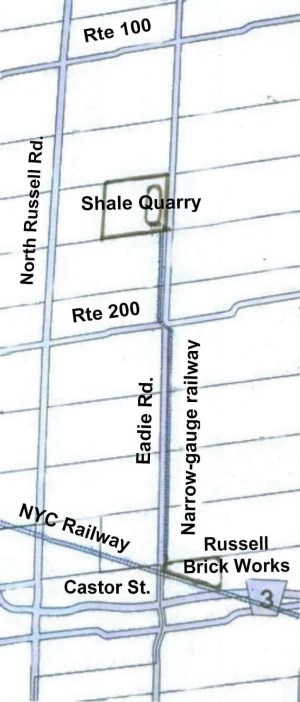
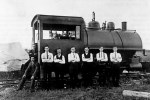
Later a saddle tank steam locomotive was used to pull 16-18 cars at a time down to the brick plant.
The wooden shale cars were replaced by side dumping cast iron shale cars. Each car weighed about a ton and would carry about three and a half tons of shale.
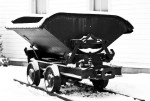
On arrival at the brick plant the tank engine would push 2 or 3 cars at a time up a ramp and dump their loads into the crushers. The shale was crushed, mixed with clay and water, moulded into bricks, and fired in one of the two kilns. When all the shale cars were unloaded, they would be assembled into a train of empties and returned to the pit where the cycle would recommence.

For its day, it was one of the most modern plants of its kind and it attracted skilled workers from England, Scotland, and Ireland. At its peak production it employed 125 men and produced up to 65,000 bricks per day. The finely crushed shale was mixed with local clay, water and other ingredients and kneaded until it became “pug” a dough-like substance. The pug was pressed into moulds lined with sand. The moulded “green bricks’ were air dried and were then fired (baked) in kilns. The brick mould stamped the name “RUSSELL” on the bricks.

The brick works had two kilns: a down draft kiln and a side draft kiln. The down draft kiln was considered the better of the two as it produced a more even heat. While bricks were baking in the kiln, salt was added through ports which changed the colour of the bricks and made them waterproof. There were three dedicated sidings built into the brick works from the main railway line for the loading of railway cars. Russell Brick was shipped to markets via the New York Central Railway (NYC) to Ottawa, Montreal and as far away as New York City.
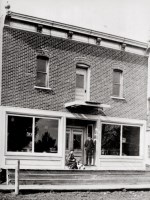
One of the first village buildings built with Russell shale brick, was the McArthur-Warner store on Mill St. in 1908.
Other examples of the use of Russell shale brick in the Village, are the Hayes/MacEwan House on Concession St. and the Boyd House on Castor St. built around the same time in 1908.
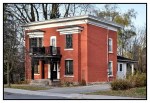
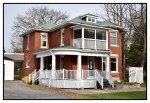
The original section of the Ottawa Civic Hospital on Carling Ave. was also built with Russell shale brick in 1924.

World War 1 brought a slump in building construction, as men from all over Canada signed up to serve overseas. There was a total of 153 men who gave Russell as their home address. During the war, the main market for Russell brick was Montreal with the railcars being transferred to the Canadian Pacific Railway line in Finch. When the Montreal based La Prairie Brick Company realized that Russell Shale Brick had a superior product, they purchased the majority of the shares in the Russell plant in 1923 and closed the plant down. 
The Russell brick works was sold to Zagerman Brothers of Ottawa in 1929 on the condition that all the buildings be demolished. Later that same year, Zagerman sold the North Russell shale quarry and the narrow-gauge railway to Duncan Merkley of Ottawa Brick and Terra Cotta Tile Co. Ltd. The new owners tore down the Russell brick plant and began shipping shale from the North Russell quarry to their Ottawa plant at Billings Bridge (where Billings Bridge Shopping Centre is now situated). With the Russell Brick Works closed, raw shale from the North Russell quarry was shipped on the New York Central Railway to Ottawa. In1938, Jack Eastman of Marvelville started trucking the shale to Ottawa. This began the yearly shipment of shale from the quarry to make bricks in Ottawa. The narrow-gauged railway into the village of Russell was torn up. The Billings Bridge plant operated until 1959 when the federal government expropriated the land and demolished the plant. The North Russell Shale quarry was sold to Domtar in 1960. Domtar built a new brick making plant in Gloucester at the intersection of Rideau Rd and Highway 31. In 1997, Domtar sold the entire operation to Canada Brick which was then purchased by Hanson Building North America products in 2005. Hanson refocused their operations in southwestern Ontario and closed the Gloucester plant in 2007. In 2008, the North Russell Shale quarry was sold to a Taggart Family numbered company that became Taggart-Miller Environmental Services. They were proposing to build a waste landfill on the quarry site. 
During the years leading up to World War I, some of the finest bricks in the country were being produced right here in Russell. Local historian Wendell Stanley said the Russell brick industry coupled with the New York Central Railway fed the boom era of the early 1990s, that produced new businesses and houses and gave Russell the opportunity to make itself known.
